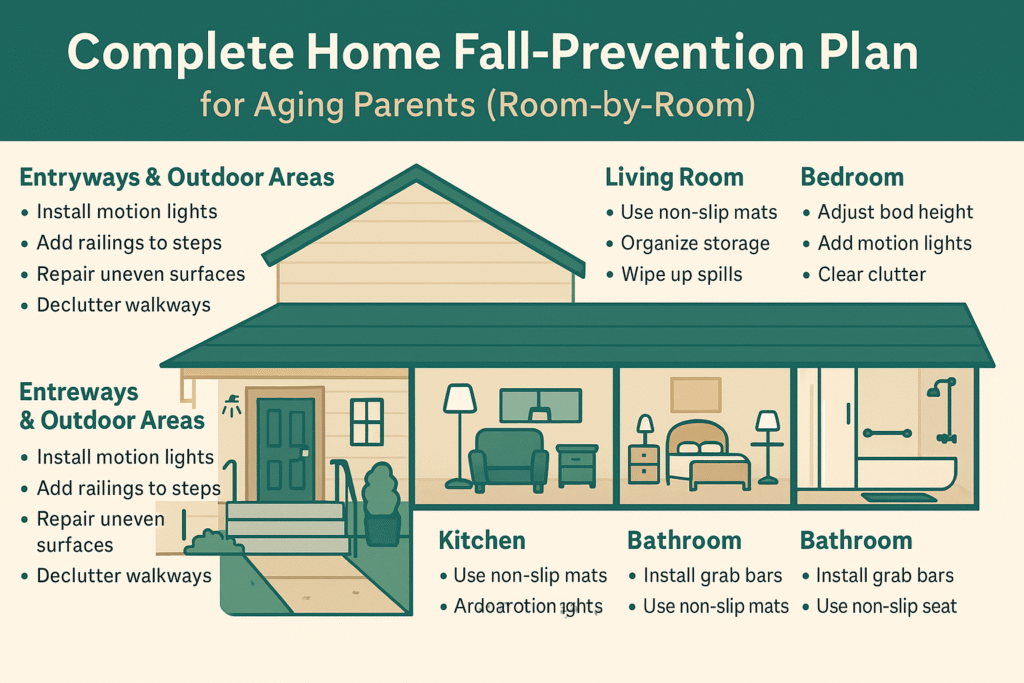
At Home Fall Prevention
Falls are the number one cause of injury-related hospital visits among seniors—and most of those accidents happen at home. For adult children supporting their aging parents, fall prevention isn’t just about safety—it’s about giving your loved ones the freedom to stay independent while giving you peace of mind.
Table of Contents
- Why Fall Prevention Matters
- Entryways & Outdoor Areas
- Living Room & Common Areas
- Kitchen
- Bedroom
- Bathroom
- Hallways & Stairs
- Laundry Room & Utility Areas
- Home Technology for Fall Prevention
- Professional Help & Resources
- Room-by-Room Quick Checklist
- Conclusion
Why Fall Prevention Matters
- 1 in 4 adults over 65 falls each year.
- ~60% of falls happen inside the home.
- Seniors who experience a fall are 2–3× more likely to fall again.
- Falls often lead to hospital stays, reduced mobility, and loss of independence.
The goal isn’t to “baby-proof” the home, but to optimize the environment so parents can live confidently in the space they love.
Entryways & Outdoor Areas
Common Risks
Uneven surfaces, poor lighting, steps without railings, clutter like garden tools or hoses.
Prevention Tips
- Lighting: Install motion-sensor lights by the front door, driveway, and pathways.
- Surface Safety: Repair cracked walkways and ensure steps are level.
- Handrails: Add sturdy railings on both sides of outdoor steps.
- Non-Slip Surfaces: Apply anti-slip strips or textured paint to stairs.
- Declutter: Store hoses, tools, and gardening supplies neatly.
Helpful Upgrades
- Outdoor grab bars for porch steps
- Solar-powered pathway lights
- Smart doorbell cameras (extra visibility and safety)
Living Room & Common Areas
Common Risks
Throw rugs, low furniture, power cords, poor lighting.
Prevention Tips
- Remove Trip Hazards: Eliminate or secure throw rugs with non-slip backing.
- Furniture Arrangement: Create wide, clear walking paths.
- Cords & Wires: Use cord covers or secure them against walls.
- Lighting: Add floor or table lamps with bright LED bulbs.
- Seating: Choose firm chairs with armrests for stable sit-to-stand.
- Smart Lighting: Consider voice- or motion-activated lights for evenings.
Kitchen
Common Risks
Slippery floors, reaching for high shelves, spills, poor storage.
Prevention Tips
- Slip-Resistant Flooring: Use non-slip mats near sink and stove.
- Accessible Storage: Store everyday items within waist-to-shoulder height.
- Spill Management: Keep paper towels and mop easily accessible.
- Task Lighting: Install under-cabinet lighting for counters.
- Step Stool Safety: Avoid unstable stools; if necessary, use a wide, handrail-equipped stool.
Helpful Upgrades
- Pull-down shelving and pull-out drawers
- Lazy Susans for corner cabinets
- Automatic shut-off kettles & appliances
Bedroom
Common Risks
Getting in/out of bed, clutter on the floor, poor night lighting.
Prevention Tips
- Bed Height: Aim for knee-level height to ease transfers.
- Clear Paths: Keep floors free from clothing, shoes, and cables.
- Night Lights: Place motion-sensor lights between bed and bathroom.
- Stable Furniture: Use sturdy bedside tables.
- Assistive Devices: Consider bed rails or a transfer pole.
- Smart Controls: Voice assistants to control lighting and calls.
Bathroom
This is the #1 danger zone for seniors. Slippery surfaces, water, and poor design make bathrooms a hot spot for falls.
Prevention Tips
- Grab Bars: Install next to the toilet and inside/outside the shower.
- Non-Slip Mats: Use textured mats inside the shower/tub and absorbent mats outside.
- Raised Toilet Seats: Easier transfers reduce strain.
- Walk-In Shower: If possible, replace tubs with low-threshold showers.
- Shower Chairs: Provide stable seating during bathing.
- Hand-Held Shower head: Increases comfort and reduces reaching.
- Anti-Scald Faucets: Prevent burns and sudden movements.
Hallways & Stairs
Common Risks
Poor lighting, clutter, steep steps, missing handrails.
Prevention Tips
- Continuous Lighting: Bright, even lighting along halls and staircases.
- Handrails: Rails on both sides; extend beyond the first and last step.
- Floor Safety: Add non-slip stair treads.
- Declutter: Keep hallways completely clear.
- Contrast: Use high-contrast tape on stair edges for visibility.
- Motion Lights: Reduce nighttime accidents.
Laundry Room & Utility Areas
Common Risks
Carrying heavy baskets, slippery floors, stacked appliances.
Prevention Tips
- Appliance Height: Elevate front-load washers/dryers (use pedestals).
- Floor Safety: Non-slip mats in laundry areas.
- Lifting Safety: Provide rolling laundry carts.
- Lighting: Bright, shadow-free task lighting.
Home Technology for Fall Prevention
Technology can’t replace physical safety, but it can provide extra protection.
- Medical Alert Systems: Wearable pendants or watches that call for help.
- Smart Lighting: Voice/motion-activated lights for safe navigation.
- Fall Detection Sensors: Some smartwatches and devices auto-detect falls.
- Video Doorbells & Cameras: Improve visibility and security.
Professional Help & Resources
Sometimes, the safest way to get started is with an in-home safety assessment:
- Occupational therapists can evaluate home risks.
- Certified Aging-in-Place Specialists (CAPS) recommend modifications.
- Local agencies on aging often provide free or low-cost assessments.
Helpful Resources
Room-by-Room Fall-Prevention Checklist (Quick Reference)
- Outdoor: Fix walkways, add railings, motion lighting.
- Living Room: Secure rugs, arrange furniture, cord covers.
- Kitchen: Store items within reach, non-slip mats, task lighting.
- Bedroom: Bed at knee height, motion night lights, clear pathways.
- Bathroom: Grab bars, non-slip mats, raised toilet seat, shower chair.
- Hallways/Stairs: Bright lights, dual railings, stair treads, clutter-free.
- Laundry/Utility: Non-slip mats, elevated appliances, rolling carts.
- Technology: Medical alerts, fall-detection devices, smart lighting.
Conclusion
Creating a fall-prevention plan isn’t just about avoiding accidents—it’s about giving your parents the confidence to live independently and giving you the reassurance that they are safe at home.
Start small—one room at a time. Each improvement builds toward a safer, smarter, and more supportive home environment. And remember—fall prevention isn’t a one-time task. It’s an ongoing process of monitoring, adjusting, and caring.
By following this room-by-room plan, you’ll reduce risks, prevent injuries, and help your parents age in place with dignity and peace of mind.
Want a printable checklist? Jump to the quick reference and save it for your next home walk through.